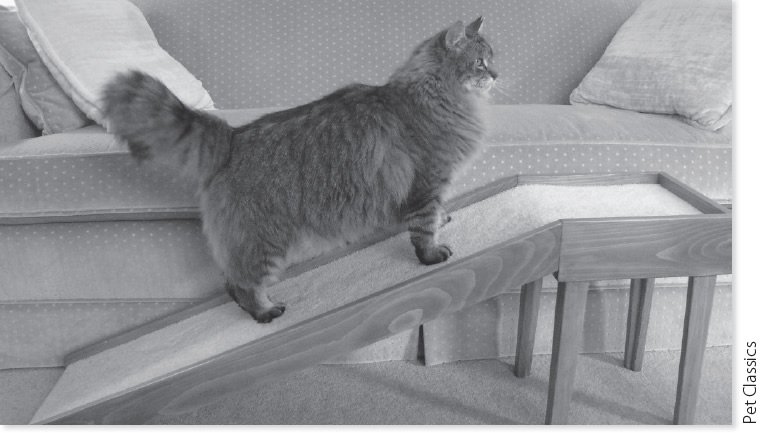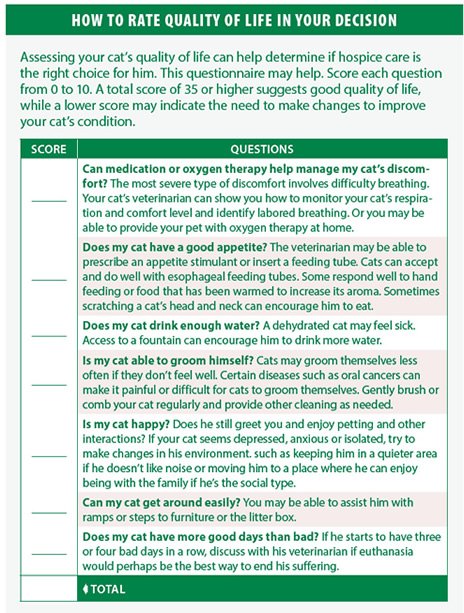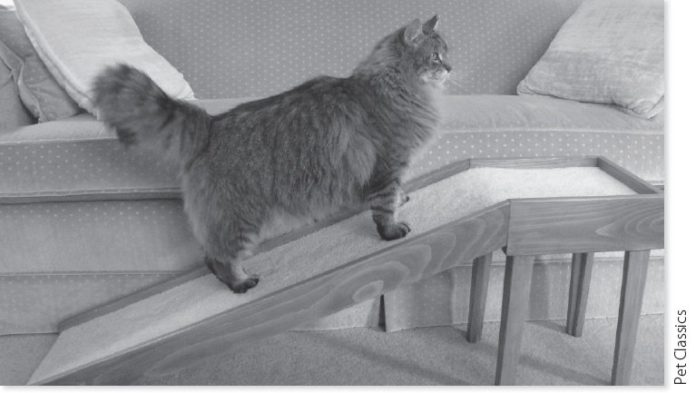
Whether your cat is suffering from disease or the effects of extreme old age, a time may come when medical treatment can no longer help. In the past, that might have meant euthanizing your cat.
Today, however, veterinarians increasingly suggest hospice care as an option. Some clinics offer house calls with staff members providing hospice services, while in some cases owners decide to provide care at home under veterinary supervision.
Natural Process. “Hospice is a philosophy of care that accepts dying as a natural process and embraces quality over quantity of life,” says Katherine Goldberg, DVM, a lecturer on the topic at Cornell University College of Veterinary Medicine and founder of Whole Animal Veterinary Geriatrics & Hospice Services. “Hospice prioritizes living fully until the last moment of life.”
Hospice focuses on pain and symptom relief, communication and help navigating the healthcare system, Dr. Goldberg says. “In both veterinary and human palliative medicine, we view the family as the unit of care, not solely the patient.”
Hospice is an alternative to the isolation of staying in intensive care or remaining at home without treatment, according to the American Association of Feline Practitioners. Even if curative treatment is no longer possible or desirable, much can be done to help a cat live comfortably for a time. If you’re considering hospice once it’s clear that additional treatments are unlikely to change the course of your cat’s health, you and his veterinarian can discuss whether hospice is a good choice.
Individualized care may mean being able to spend more time with your cat, but it represents a big commitment. All family members should agree on it and understand how it works. Issues to discuss with the veterinarian include expenses, logistics of travel to and from treatment centers, home care techniques and training, and religious considerations.
Ask if the veterinary clinic has a dedicated hospice team to provide support for you and your cat. Team members can educate you on recognizing and evaluating pain levels and advancing stages of organ failure. After your cat’s death, they can help provide emotional support.
Dr. Goldberg also recommends a frank discussion with the veterinarian about your goals, fears and expectations. What tradeoffs are you willing to make? Make sure you understand your cat’s condition and its progression. Quality of life is the most important factor in caring for a terminally ill cat. It’s a measure of how your cat is faring physically, mentally and socially.
“The philosophy of maintaining quality of life at the end of life honors the human-animal bond,” says Alice Villalobos, DVM, who is considered the godmother of hospice for pets, which she calls “pawspice.”
The specifics of hospice involve a variety of techniques, from noncurative care such as pain management to infection control, nutritional support, subcutaneous fluids for kidney failure, noncurative surgical procedures and hands-on attention for the cat throughout the day, not only when he’s receiving medication.
If remission is unlikely in the case of a cat with cancer, the veterinarian may recommend metronomic chemotherapy. It provides chemotherapy drugs in fractionated doses — a continuous, low-dose chemotherapy. The side effects are reduced and may lead to greater survival time.
Owner and veterinarian must find the best drugs to relieve pain and methods of delivery acceptable both to you and your cat. Multiple types of pain relievers are available and some can be used together to reduce pain to a manageable level.
Work with the veterinarian to develop a treatment plan. Have a conversation about the easiest ways for you to medicate your cat — pills, injections or liquids — as well as your work schedule and any physical limitations. For instance, people with arthritis may have difficulty opening pill bottles or manipulating small syringes.
Discuss areas where you’re willing to compromise. Are you willing to give pills twice daily to your cat but unwilling to give injections? What is your cat’s level of acceptance of various treatments and interventions?
Symptom management is necessary even when the causes aren’t evident, for instance in cases when a pet is nauseated and an antacid or anti-nausea medication may help, Dr. Goldberg says. “Sometimes, in the absence of a diagnosis, we need to trial-treat judiciously and see if there is a clinical response. This requires excellent communication and follow-up.”
There is no right or wrong decision about hospice. It’s not for everyone, and that’s all right. But if you choose it, you may be rewarded with additional time with your special cat and he could have a peaceful, pain-free end of life.





